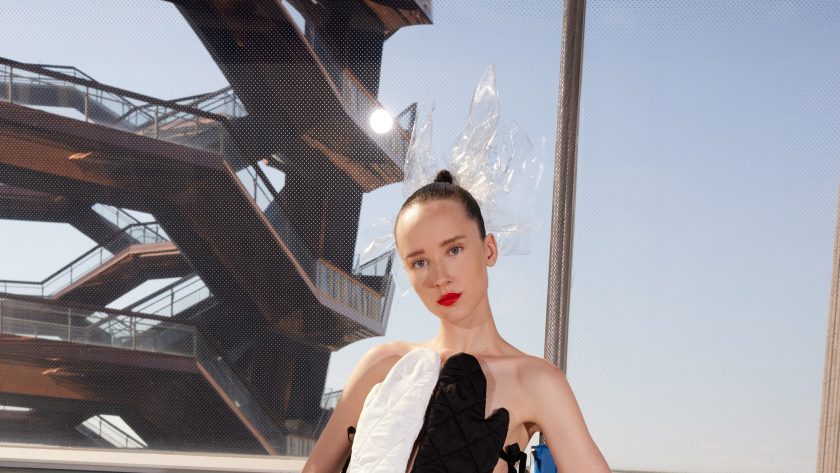The designer Batsheva Hay is in her experimental era. For the past few seasons she has been pushing against the limits that delineate what her brand can be, the things that she’s allowed to make—the trick being that she’d set those original limits herself. “I have no classical fashion background, so I learned with cut-and-sew garments, and it was all handed off,” she explained in a quiet storage room in her studio in the Garment District a day before her show. “I used to feel like I couldn’t work with the garments. I had to hand things over, then pick them up, and it was very nice for my lifestyle. Then I’d go home and nurse my baby and then hand her off, pick the clothes up, pick out the buttons or whatever.” She laughed at the familiar juggling of so many women who go home at the end of a workday for a different kind of work. “But now I find the really fun part is tearing things, shredding things, adding little bustles, pinning things onto things. And I do think that’s an important part of what distinguishes my brand from other brands; that there’s a little bit of naivete in it. It’s not quite feral, but just the amateurness of it all.”
These “grotesque experiments,” as Hay calls them, involved her pinning a surplus of cotton placemats and oven mitts that she had lying around. “I just started safety-pinning them on my body, and I thought, Oh, it’s so sexy,” While the oven-mitt dress feels very much like oven mitts that have been safety-pinned together when you’re just “being goofy,” the experimentation did take her to some groovy places. Like the dress made from delicately embroidered cotton placemats, which has a sort of romantic quality to it, and the top made from floral-print cotton placemats, which Hay draped over a white cotton “cheerleader full-circle skirt” with turquoise godets further propped up by a hoop skirt underneath. If it all sounds a little nutty, it is, but it also feels wearable and oddly accessible. Hay expanded, elongated, or otherwise stuffed some of her go-to silhouettes, like the turquoise dress modeled by Amy Fine Collins, which is one of her bestsellers, and the high-waist, pleated skirt in turquoise with embroidered kissy prints, which she makes every season in different fabrications. An oversized white T-shirt was stuffed underneath a corset and worn with a white ball-gown skirt, and it looked fabulous and odd. The clothes are fun because Hay is clearly having fun while making them. (She was also having fun at her presentation inside the new BondST restaurant at Hudson Yards, where models holding little number signs walked around guests, midcentury couture show style, while Hay narrated the looks and then opened the floor for questions and comments from the audience.)
On the day of my studio visit, Hay was wearing a turquoise version of the floral cotton gown modeled by Jordan Roth; its silhouette could be best described as Disney princess, with its oversized bow at the bust, full skirt, and built-in cape—and yet, made from a very humble cotton fabric, it seemed like any other day dress one might wear on a sweltering hot day. “It’s not a commercially sensible dress, because who wears a cotton dress with a cape?” she asked. But couldn’t she make the cape detachable? “I could…but I don’t think I will.”



